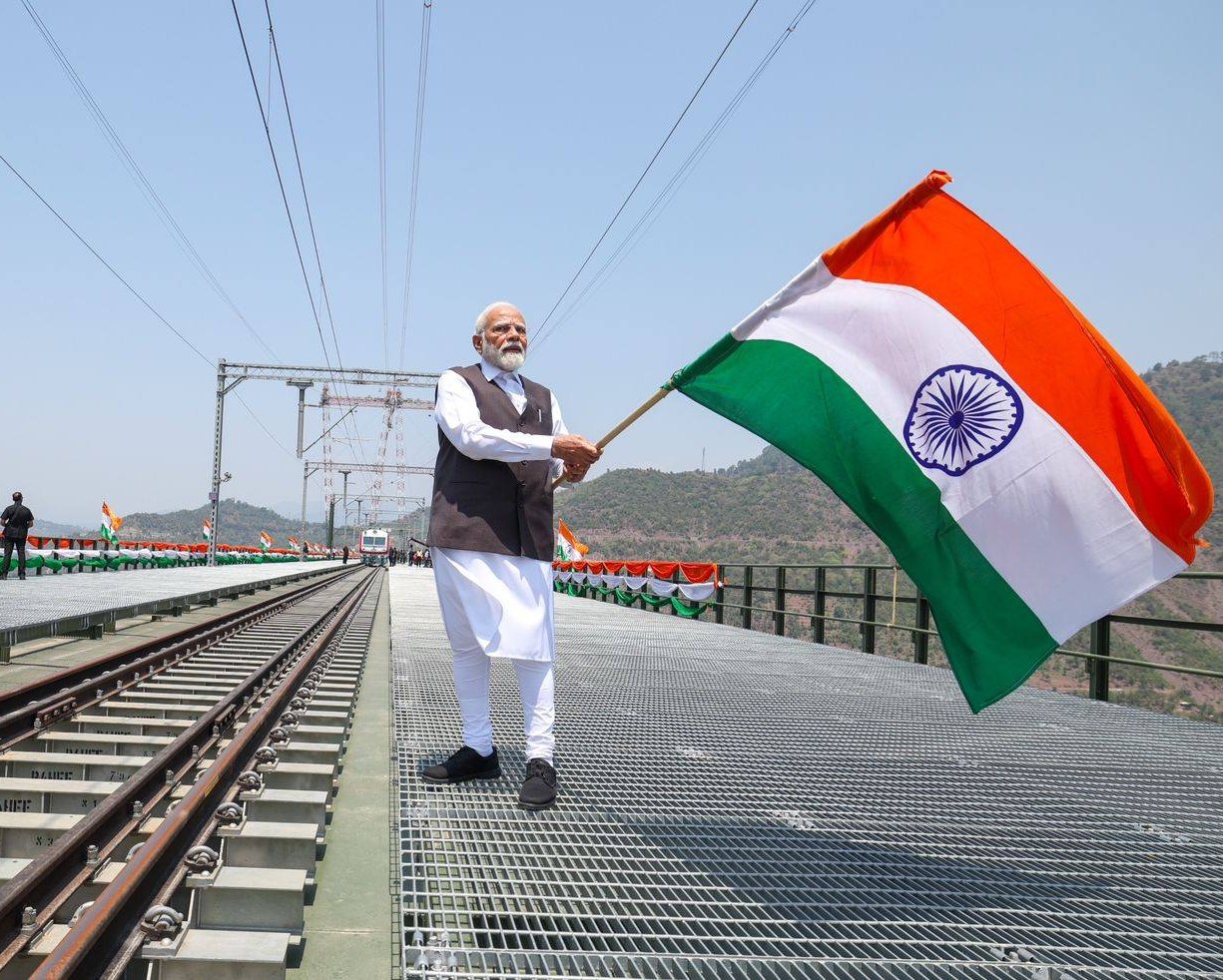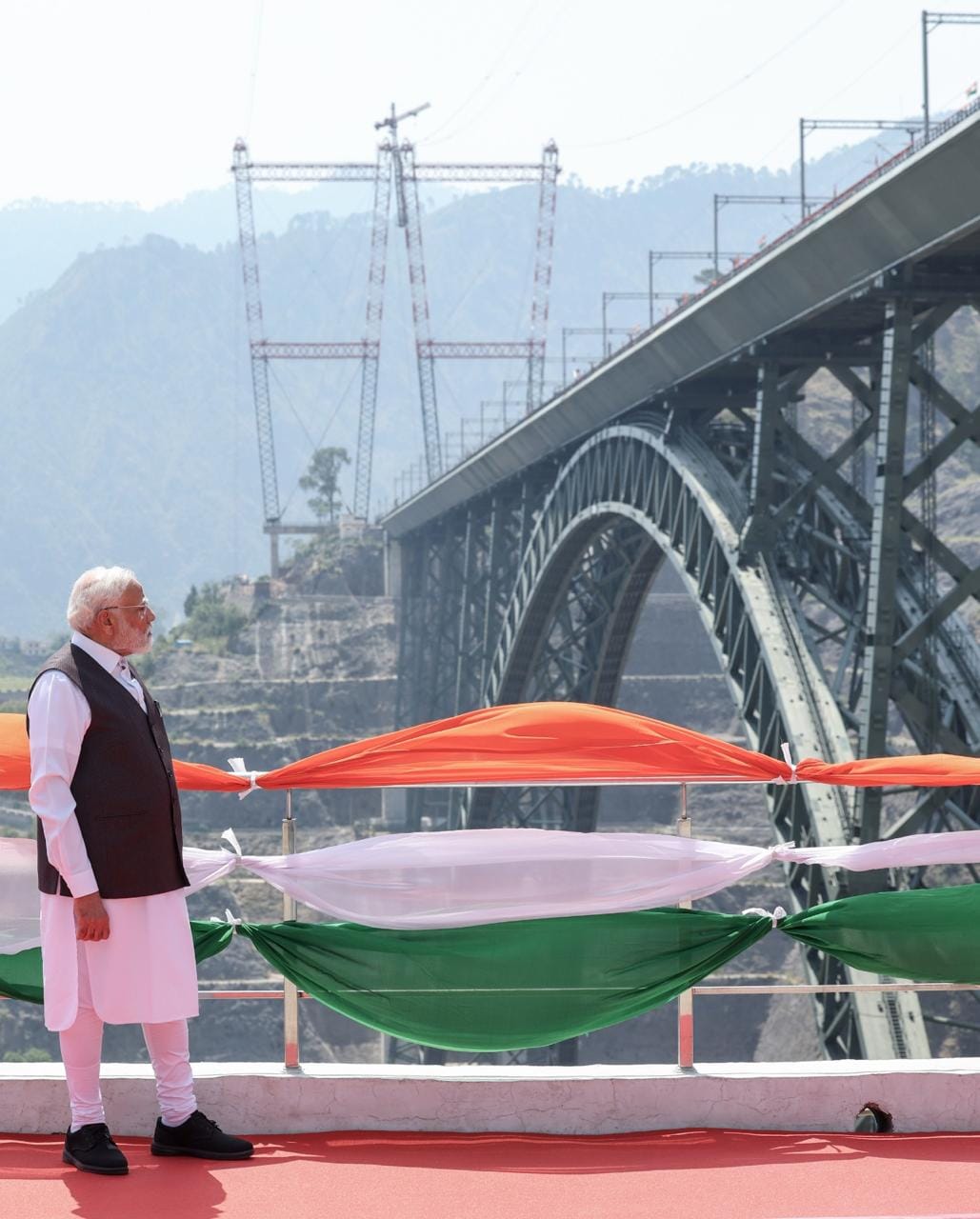The world’s highest railway bridge isn’t just about steel and elevation—it’s about connecting hopes, markets, and a long-divided land
By Ajaz Rashid
On June 6, 2025,  inaugurated what many consider India’s most ambitious infrastructure achievement since independence—the Chenab Railway Bridge, the world’s highest railway arch bridge soaring 359 meters above the turbulent waters of the Chenab River . This engineering marvel, part of the ₹43,780 crore Udhampur-Srinagar-Baramulla Rail Link (USBRL) project, represents far more than mere connectivity; it symbolizes Kashmir’s definitive integration into India’s developmental narrative and economic mainstream. The 272-kilometer railway network, featuring 36 tunnels spanning 119 kilometers and 943 bridges, has fundamentally transformed the region’s accessibility dynamics, reducing travel time between Katra and Srinagar to just three hours while generating over 14,000 jobs during construction.
inaugurated what many consider India’s most ambitious infrastructure achievement since independence—the Chenab Railway Bridge, the world’s highest railway arch bridge soaring 359 meters above the turbulent waters of the Chenab River . This engineering marvel, part of the ₹43,780 crore Udhampur-Srinagar-Baramulla Rail Link (USBRL) project, represents far more than mere connectivity; it symbolizes Kashmir’s definitive integration into India’s developmental narrative and economic mainstream. The 272-kilometer railway network, featuring 36 tunnels spanning 119 kilometers and 943 bridges, has fundamentally transformed the region’s accessibility dynamics, reducing travel time between Katra and Srinagar to just three hours while generating over 14,000 jobs during construction.
Defying Nature’s Extremes
The Chenab Bridge stands as a testament to human ingenuity overcoming seemingly insurmountable geographical challenges. Rising 35 meters higher than the Eiffel Tower, this 1,315-meter steel arch structure was designed to withstand winds of up to 266 km/h and earthquakes measuring magnitude 8.0. The bridge’s construction required 25,000 metric tons of steel and concrete, with specialized structural materials capable of enduring temperatures ranging from minus 20 to 40 degrees Celsius.
The engineering complexity extended beyond the bridge itself, around the entire USBRL project’s navigation through the seismically active Himalayan terrain. Construction teams faced unprecedented challenges, including excavating approximately 1.2 million cubic meters of earth and employing sophisticated blast-resistant technology developed by the Defence Research and Development Organisation (DRDO). The bridge incorporates a unique 780-meter blast protection platform—the first of its kind in India’s railway sector—designed to absorb explosion impacts during train operations.
Economic Integration
The USBRL project’s economic implications extend far beyond its ₹43,780 crore investment, positioning Kashmir as a crucial node in India’s expanding transportation network. The railway link enables year-round connectivity, eliminating the region’s historical dependence on weather-vulnerable road transport that frequently disrupted commerce during harsh winters. Local producers of saffron, apples, and traditional handicrafts now benefit from direct access to national and international markets, with transportation costs expected to decrease significantly.
The project’s ripple effects are already visible in regional commerce patterns. Farmers can now transport fresh produce to metropolitan markets within hours rather than days, while artisans gain unprecedented access to broader consumer bases. The railway connection facilitates the movement of essential goods into the Valley at reduced costs, potentially lowering living expenses for residents while stimulating local business development.
Employment Generation
 The USBRL project emerged as a significant employment generator, creating over 14,000 jobs during construction with 65 percent allocated to local workers. The project provided government employment to 804 families who lost more than 75 percent of their land to the railway development, while generating more than 525 lakh man-days of employment. This massive undertaking fostered a skilled workforce now contributing to infrastructure projects across India.
The USBRL project emerged as a significant employment generator, creating over 14,000 jobs during construction with 65 percent allocated to local workers. The project provided government employment to 804 families who lost more than 75 percent of their land to the railway development, while generating more than 525 lakh man-days of employment. This massive undertaking fostered a skilled workforce now contributing to infrastructure projects across India.
Beyond direct employment, the railway construction spurred ancillary economic activities, with local communities establishing workshops, eateries, and service businesses along the construction corridor. The project built over 215 kilometers of approach roads, connecting 70 remote villages housing approximately 1.5 lakh residents to mainstream transportation networks. Previously isolated communities relying on treacherous footpaths now enjoy access to markets, educational institutions, and healthcare facilities.
Tourism Revolution
The Chenab Bridge inauguration coincided with the launch of specially designed Vande Bharat Express trains connecting Katra and Srinagar, engineered specifically for Kashmir’s extreme climate conditions. These trains, equipped with heated windshields, sophisticated heating mechanisms, and insulated facilities, maintain efficient operations even when temperatures plunge to minus 20 degrees Celsius. The service reduces travel time by approximately 50 percent compared to road transport, making Kashmir more accessible to domestic and international tourists.
Tourism industry experts anticipate substantial growth following the railway connection’s operationalization. Deepak Kumar Bhatnagar from the Indian Association of Tour Operators emphasized that “better connectivity always helps to improve tourism places,” noting that direct rail links typically increase visitor preferences significantly. The railway facilitates access to major pilgrimage sites including Amarnath, Hazratbal, and Charar-e-Sharif, expected to boost religious tourism substantially.
The tourism sector’s transformation extends beyond mere accessibility improvements. Middle-class travelers, previously deterred by high airfare costs or time-consuming road journeys, now have an affordable, comfortable alternative. Chamber of Commerce representatives predict that the railway will establish Kashmir as a premier tourist destination by offering safe, quick, and scenic travel options while reducing overall tourism costs.
Community Perspectives
While the project represents a significant developmental achievement, community reactions reveal complex perspectives on Kashmir’s integration process. Some residents express concerns about land acquisition and consultation processes, questioning whether local communities were adequately involved in project planning. Kashmiri farmers, particularly in areas designated for future rail extensions like the Srinagar-Pahalgam route, have raised concerns about potential land dispossession.
Conversely, many locals like Shair Khan from Reasi district view the bridge as a “lifeline,” especially during challenging winter months when heavy snow and landslides traditionally isolated communities. Khan noted that “with this bridge, we hope to stay connected all year round,” expressing optimism about increased business opportunities and year-round connectivity.
The project has also created unexpected regional dynamics, with Jammu’s transport and hospitality sectors expressing concerns about reduced economic dependence. Traditional transporters and hoteliers worry that direct Kashmir-mainland connectivity will bypass Jammu, potentially impacting local businesses that historically served as intermediary points.
Environmental Considerations
Environmental impact assessments conducted for the USBRL project addressed multiple ecological concerns, including air quality, noise pollution, and water environment impacts within specified influence zones. The assessment framework established monitoring protocols covering 50-meter areas of influence for air quality, 100-meter zones for noise pollution, and 200-meter ranges for water body impacts.
The Chenab basin’s cumulative environmental impact assessment, conducted in response to judicial directions, evaluated the aggregate ecological effects of hydropower development and infrastructure projects on the river system. The study aimed to assess impacts on aquatic fauna and flora, biodiversity of riverine ecosystems, and overall ecological integrity. Researchers from the Indian Institute of Science developed comprehensive frameworks for analyzing rock slope stability and geological challenges, ensuring the bridge’s environmental sustainability.
Despite environmental precautions, some critics argue that large-scale infrastructure development in ecologically sensitive Himalayan regions requires more comprehensive consultation and impact mitigation. The project’s environmental management plan includes mitigation measures for identified negative impacts and post-project monitoring protocols to ensure compliance with regulatory standards.
Strategic Significance and National Security
Beyond its civilian applications, the Chenab Bridge holds considerable strategic importance for India’s border security and military logistics. The railway provides enhanced mobility for Indian Armed Forces in border areas, facilitating rapid deployment and supply chain management in challenging terrain. The all-weather connectivity addresses historical vulnerabilities created by seasonal road closures that previously limited military and civilian movement.
The bridge’s blast-resistant design, incorporating DRDO-developed technology, reflects security considerations in a region historically affected by insurgency and cross-border tensions. Railway Protection Force commandos, deployed for the first time in Jammu and Kashmir, provide security for Vande Bharat trains with 15 commandos and supervisors on each service.
Key Statistics and Milestones of the Chenab Bridge and USBRL Project
Engineering Dreams into Reality
The Chenab Bridge inauguration marks the culmination of a 42-year vision that began with the railway project’s conception in 1983. From initial cost estimates of ₹2,500 crore to the final investment of ₹43,780 crore, the project exemplifies India’s commitment to overcoming geographical challenges through technological innovation and sustained investment. The bridge’s 120-year design life ensures that this engineering marvel will serve multiple generations, fundamentally altering Kashmir’s relationship with the Indian mainland.
As trains now traverse the world’s highest railway bridge, connecting the “Valley of Steel and Dreams” to India’s broader economic landscape, the Chenab Bridge revolution represents more than infrastructure development—it symbolizes the transformation of aspirations into tangible reality. The project’s success demonstrates that with adequate planning, investment, and technological expertise, even the most challenging geographical barriers can be overcome, opening new horizons for regional development and national integration.
The railway’s operational commencement on June 7, 2025, with regular six-day weekly services, marks not just a transportation milestone but a new chapter in Kashmir’s developmental narrative. As the first trains carry passengers across the towering steel arch above the Chenab River, they transport not just people and goods, but dreams of prosperity, connectivity, and integration that have finally found expression in this engineering marvel.
Leave a Reply